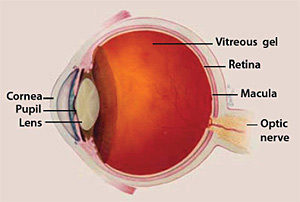Blog
Macular Edema

What is macular edema?
The macula is the central part of the retina—the light-sensing tissue in each eye. The macula is responsible for sharp, “straight-ahead” vision. Macular edema is the build up of fluid in the macula, causing it to swell and distorting vision.
What causes macular edema?
Damaged blood vessels in the retina may leak, causing fluid to accumulate. A leading cause of macular edema is diabetic retinopathy. Macular edema can also develop with:
- Eye surgery, such as an operation for cataracts, glaucoma, or retinal disease
- Age-related macular degeneration (AMD), particularly “wet” AMD, where abnormal blood vessels leak into the macula
- Eye inflammation and certain autoimmune disorders
- Any disease that harms or blocks the blood vessels of the retina
What are the symptoms of macular edema?
If you have macular edema, you may experience central vision that seems blurry or wavy, or colors may appear washed out or faded. You may also find it hard to read.
How is macular edema diagnosed?
The best way to learn if you have macular edema is to get a comprehensive dilated eye exam from an eye care professional. Other tests used to diagnose AMD include:
- Amsler grid. Your doctor may ask you to look at an Amsler grid, which is a simple grid of black lines on a white background. If you have macular edema, the lines of the grid may disappear (especially in the middle) or appear wavy.
- Fluorescein angiogram. A fluorescent dye is used to see the blood vessels in your eyes to determine if they are leaking.
- Optical coherence tomography is an imaging test that uses light waves to capture images of your eye tissue.
Can macular edema be treated?
The first line of treatment is to manage whatever is causing your macular edema, such as controlling high blood sugar if you have diabetic macular edema. You may also have one or more of these therapies:
- Anti-VEGF injections. Therapies that target a protein called “vascular endothelial growth factor” (VEGF)—such as aflibercept, bevacizumab, or ranibizumab—inhibit abnormal blood vessel growth and are the current standard of care for macular edema. These treatments are injected into the eye. Anti-VEGF therapies can slow vision loss and even improve vision in some people. Repeated treatments are needed to achieve the most benefit.
- Laser surgery. This approach may be used to seal off leaking blood vessels in the macula.
- Corticosteroids. Some patients receive corticosteroid injections, eye drops, or pills to control inflammation in macular edema. Examples include dexamethasone and fluocinolone acetonide.
- Nonsteroidal anti-inflammatory drugs, administered as eye drops, are an option for people with macular edema that does not respond well to steroids.
- Vitrectomy. People who have macular edema caused by the vitreous (the gel-filled area in the center of the eye) pulling on the macula may have the vitreous surgically removed and replaced with a saline solution.
Source: The National Eye Institute (NEI)
Join our Mission
Lighthouse Guild is dedicated to providing exceptional services that inspire people who are visually impaired to attain their goals.
